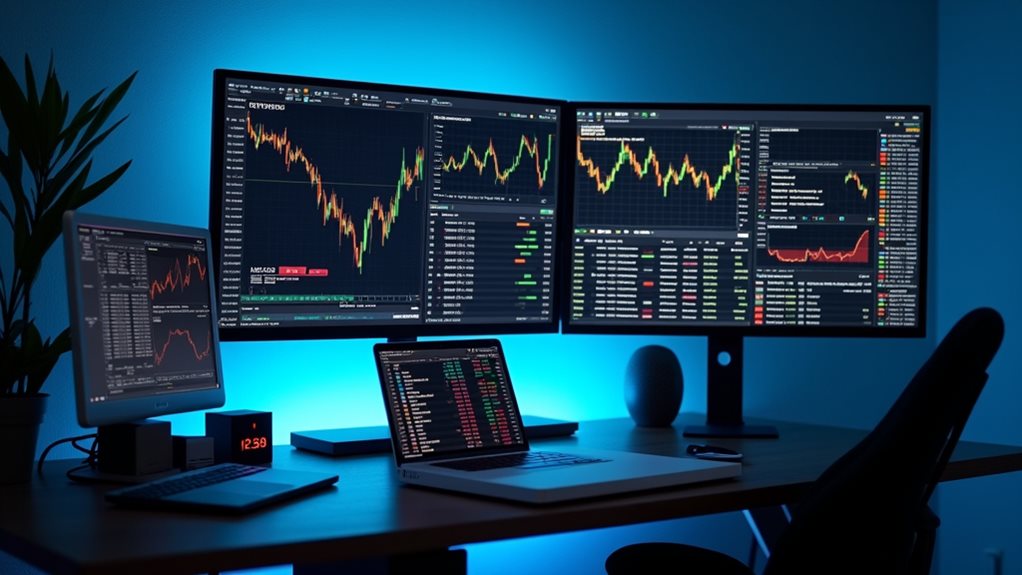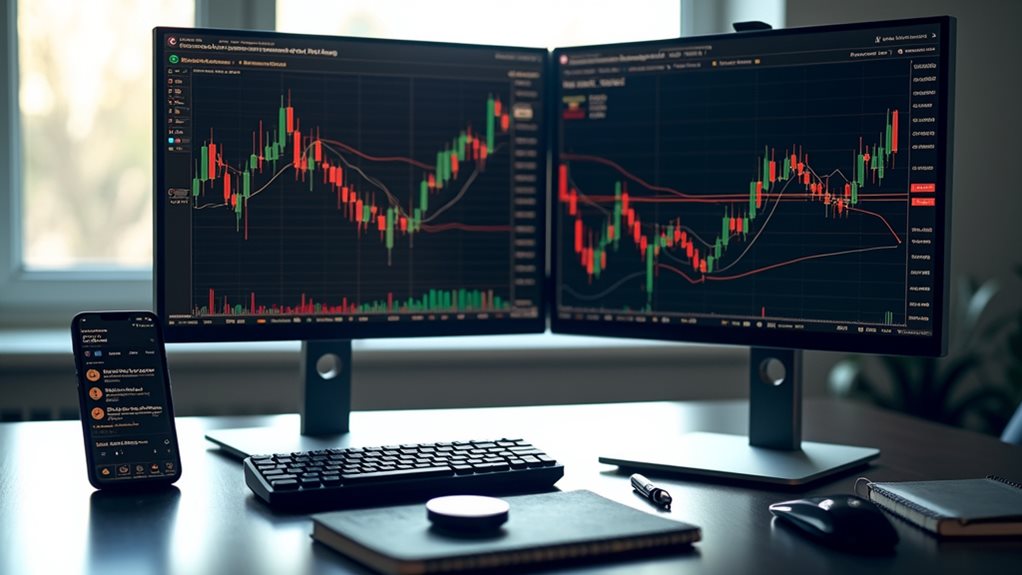Cryptocurrency trading pairs are the foundation of crypto exchanges. They're simply two assets exchanged for each other—like BTC/USDT or ETH/BTC. Each pair has a base currency (what you're buying) and quote currency (what you're paying with). In 2025, Bitcoin and Ethereum pairs still dominate, but stablecoins are essential for security. Liquidity matters—it determines how easily you can trade without price impact. The crypto landscape changes fast; understanding these basics gives you a fighting chance.
What Are Cryptocurrency Trading Pairs?

When you plunge into the crypto world, trading pairs hit you first. They're simply two assets that can be exchanged for each other. Nothing fancy. BTC/ETH means you're trading Bitcoin for Ethereum. BTC/USD? That's Bitcoin for good old American dollars.
These trading pair fundamentals aren't just random combinations. They're the backbone of every exchange platform. They make buying and selling possible. Period.
Market behavior revolves around these pairs. They show you exchange rates in real-time, reflecting what people are willing to pay right now. They create liquidity too – the ability to trade without crashing prices. Trust me, you'll appreciate that when you're trying to exit a position quickly.
Trading pairs come in flavors: fiat-to-crypto, crypto-to-crypto, and stablecoin pairs. Each serves different needs. Trading pairs indicate the value of one cryptocurrency against another, making it essential to understand real-time values for effective trading. Each pair consists of a base and quote currency that establishes their comparative value. Choose wisely.
The Building Blocks of Trading Pairs: Base and Quote Currencies

Every trading pair consists of two critical components – they're not just random crypto symbols slapped together.
The first part is your base currency—what you're actually buying or selling. The second? Your quote currency—what you're using to do the buying.
Base currency selection matters. Choose BTC or ETH as your base, and you're playing with the big boys. Different exchanges offer different bases. That's life. High-liquidity pairs like BTC/USDT offer greater stability and better execution conditions, making them ideal for beginners entering the market.
Your quote currency impact shouldn't be ignored either. It's literally setting the price. Want to know how much your Bitcoin costs? Look at the quote currency. USDT, BTC, or something else—they all affect volatility differently. Setting up technical indicators can help you track price movements and make informed trading decisions.
The price always shows how much quote currency you need for one unit of base. Simple math, complex consequences.
In cryptocurrency markets, prices of pairs constantly fluctuate based on market supply and demand, creating both opportunities and risks for traders.
Common Types of Crypto Trading Pairs in 2025

As crypto markets have matured, distinct categories of trading pairs have emerged that dominate the landscape.
Bitcoin pairs like BTC/USDT and BTC/ETH still rule the roost—no surprise there. These high liquidity pairs attract massive trading volumes daily. U.S. traders must now use Binance.US platform for accessing these popular pairs.
Ethereum-based pairs aren't far behind. ETH/USDT, ETH/BTC, ETH/LINK—they're everywhere. You can't escape them.
Stablecoin usage has exploded since 2023. USDT leads the pack, but USDC and DAI have carved out their niches too. They're stable. Boring, but necessary. They provide transaction security through cryptographic verification, making them ideal for traders seeking stability.
Regional pairs also matter. Binance pushes BUSD, Gemini has GUSD. Different exchanges, different flavors. The expansion of these trading pairs has significantly contributed to the overall maturation of cryptocurrency markets.
The most liquid pairs? BTC/USDT and ETH/USDC. Trade these and you'll never worry about slippage. They're liquid as water.
Analyzing Trading Pair Liquidity and Volume

Beyond knowing which pairs exist, you'll need to understand what makes them tick.
Liquidity analysis tells you how easily you can buy or sell without tanking the price. Volume trends reveal market sentiment—sometimes predicting big moves before they happen.
Let's be honest, trading illiquid pairs is asking for trouble. High volume doesn't always mean healthy markets either (hello, wash trading). While analyzing ETH markets, data shows that 2% depth liquidity provides crucial insight into whether an exchange can handle your trading volume. The bid-ask spread serves as a critical indicator of market efficiency and transaction costs for traders.
- Check liquidity at different depths (0.1%, 0.2%) to gauge market resilience
- Compare volume across exchanges—Binance typically crushes the competition
- Analyze organic vs. artificial volume—fake volume is everywhere in crypto
- Examine specific pairs—ETH/USDT will always be more liquid than some obscure ETH/GBP pair
Major exchanges compete for your trades. Smart money follows liquidity.
Market Trends and Trading Pair Selection Strategy

The cryptocurrency landscape shifts faster than politicians' promises during election season.
What's hot today might freeze tomorrow. Brutal truth.
When selecting trading pairs, you'll need to factor in current market dynamics.
Hardware wallets provide essential security for serious cryptocurrency traders.
Institutional money is flooding in—finally—bringing stability to certain pairs like BTC/USDT.
Bitcoin still leads the pack, dragging altcoins behind it like reluctant children. No surprise there.
Your trading psychology matters more than you think.
Some traders thrive in high-volatility pairs; others prefer the relatively stable stablecoin pairs.
Know yourself.
DeFi and stablecoin pairs are gaining serious traction for cross-border transactions.
Worth watching.
AI-driven innovations are also reshaping how traders analyze markets.
The machines might just be better at this than you are. Sobering thought.
The expected passage of stablecoin legislation in Congress will establish clearer guidelines for issuers, potentially improving market stability for stablecoin trading pairs.
Memecoins like Dogecoin have experienced explosive growth with DOGE value increasing over 300% in 2024, making them increasingly popular trading pairs for speculative investors.
Risk Management When Trading Different Cryptocurrency Pairs

Risk management might sound boring, but it's the difference between building wealth and obliteration in crypto markets.
Your proper risk assessment is non-negotiable when juggling different trading pairs. Bitcoin-stablecoin pairs behave differently than obscure altcoin pairings. Duh. With multi-signature wallets offering limited protection, security must be a top priority in your trading strategy.
Position sizing matters more than you think. Trust me, I've seen portfolios vaporize because someone went all-in on a "sure thing." Brutal. Volatility in cryptocurrency requires risk management strategies tailored to your specific trading approach.
Understanding the correlation between assets in crypto-to-crypto pairs is crucial for effective diversification and preventing catastrophic losses during market downturns.
Here's what actually works:
- Set stop-losses for every single trade—no exceptions
- Never risk more than 1-2% of your portfolio on a single position
- Diversify across trading pairs with different risk profiles
- Review your positions daily, especially during high volatility
Markets don't care about your feelings. They'll crush you if you let them.
Advanced Trading Pair Strategies for Market Volatility

Now that you've got your risk management basics down, let's tackle what happens when markets go absolutely bonkers.
Crypto volatility isn't for the faint-hearted. Seriously.
When markets swing wildly, advanced volatility strategies become your best friend. Consider scalping techniques to capitalize on quick price movements. Short, sweet, profitable. Maybe. Consider using yield farming strategies to earn additional rewards while navigating market turbulence.
Ride the lightning with scalping. Three-second trades might just save your portfolio when everything's burning.
Pair trading techniques like correlation analysis help predict how coins move together. BTC dumps? ETH probably follows. Use it.
For the chaos-surfers among you, mean reversion strategies exploit overbought or oversold conditions in trading pairs. What goes up ridiculously fast often comes crashing down. Setting appropriate stop-loss orders is crucial when implementing these strategies to protect your capital during extreme market movements.
Combine technical indicators—Bollinger Bands with Moving Averages—for sharper insights.
And never forget liquidity. Trading illiquid pairs during volatility? Good luck with that slippage. During extreme market conditions, stablecoins offer a temporary haven to preserve value while you wait for the storm to pass, as they're specifically designed to provide USD-pegged stability.
Emerging Trading Pair Opportunities in the 2025 Market

Looking ahead to 2025, crypto trading pairs are evolving faster than regulators can write complaint letters.
The landscape's changing dramatically with decentralized exchanges leading the innovation charge. No surprise there. Trading pairs on DEXs like Uniswap and PancakeSwap offer significantly more privacy and control for traders compared to centralized alternatives. With over 16,000 altcoins available, traders have unprecedented options for pair combinations.
Watch these emerging opportunities:
- SOL/USDC pairings – Solana's high-throughput capabilities make these pairs attractive for traders seeking speed without the gas fee headaches.
- ADA-based trading pairs – Cardano's stability through Ouroboros offers less dramatic price swings.
- DeFi token/ETH combinations – Ethereum's smart contract ecosystem creates natural trading synergies.
- Community-voted pairs on Binance – Their "Vote to List" mechanism is actually working.
Emerging altcoins paired with stablecoins provide lower entry barriers. Binance will be adding five new USDC trading pairs starting March 11, 2025.
Truth is, high-liquidity pairs will always dominate, but the real opportunities lie in spotting tomorrow's winners before the herd arrives.
Top Platforms for Trading Cryptocurrency Pairs

When choosing your trading platform, the difference between profits and losses often comes down to which exchange you're using.
Let's face it—not all exchanges are created equal.
Coinbase features a beginner-friendly interface and solid mobile apps, perfect if you're just starting out.
Sure, their fees reach up to 3.99%, but that FDIC insurance up to $250,000 offers peace of mind.
Worth it? Maybe.
Kraken advantages include ridiculously low fees (0% to 0.4%) and extensive cryptocurrency options.
Serious traders love it.
The interface isn't winning any beauty contests, but who cares when you're saving on every trade?
For security fanatics, Gemini's your best bet.
Mobile enthusiasts? Crypto.com's got you covered with over 400 cryptocurrencies.
BitMart stands out for traders seeking variety with access to over 1,700 cryptocurrencies for your altcoin adventures.
Binance US balances both worlds with competitive fees and strong liquidity. Their platform stores assets using secure offline storage to protect your investments from potential hacking attempts. Users can enjoy BNB fee discounts of up to 25% when using their native token for trading.
Frequently Asked Questions
How Do Taxes Apply to Profits From Cryptocurrency Trading Pairs?
When you make profits from crypto trading pairs, you'll face tax implications that require accurate profit calculations. You're responsible for reporting all gains from crypto-to-crypto trades, which are taxed as capital gains.
Can I Create Custom Trading Pairs on Mainstream Exchanges?
You can't create custom trading pairs on mainstream exchanges due to their built-in limitations. Major platforms restrict custom pair creation, requiring you to use specialized white-label solutions or develop your own exchange instead.
How Do Trading Pairs Behave During Global Economic Crises?
During global economic crises, you'll notice trading pairs experience increased market volatility. Traditional currency correlations may break down as investors seek safe havens, though crypto often doesn't follow traditional safe-haven patterns during widespread uncertainty.
What Programming Languages Are Best for Developing Trading Pair Algorithms?
You should prioritize Python for its extensive libraries and ease of use in algorithm development, while considering C++ for efficiency in high-frequency trading when milliseconds matter. R excels for statistical analysis.
How Do Hardware Wallets Interact With Trading Pairs During Transactions?
Your hardware wallet integration secures your trading pairs by signing transactions offline. You maintain control of your keys while the wallet connects to exchanges, ensuring transaction security throughout the trading process.






